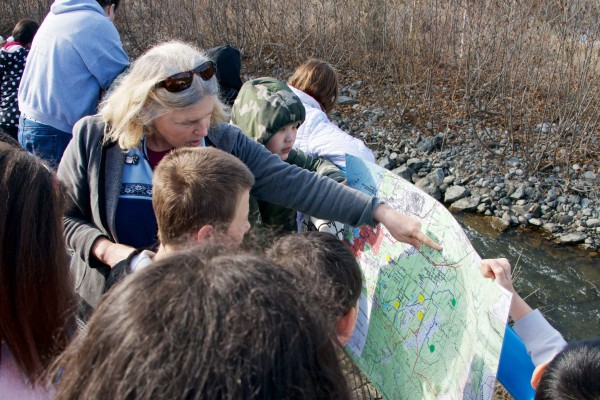About the Alaska Waters Education Resources
Project Information
Alaska Sea/River Week began with a grassroots effort by parents in Juneau in 1968 to celebrate the ocean’s bounty. The concept and related learning activities quickly spread to classrooms and communities across the state during the 1970s. The curriculum was expanded to include Alaska’s wetlands in the 1980s, and the Alaska Sea Grant Program produced the six-volume Alaska Sea/River Week curriculum. Each volume, from kindergarten through sixth grade, featured a different ocean and freshwater theme.
Governor Jay Hammond recognized the value and importance of the Sea/River Week curriculum by issuing an executive proclamation on February 4, 1982, establishing April 23–May 11 as “Alaska Sea Weeks,” and encouraging residents “to learn about and gain a greater appreciation of the wonder and beauty of the ocean.”
The National Science Teachers Association recognized the Alaska Sea/River Week program as one of its exemplary science programs in 1986. Alaska Sea Grant’s national award-winning Alaska Sea/River Week curriculum provided a critical link for teachers and students to learn about their local marine environment.
In May 2006, Alaska Sea Grant was successful in partnering with school districts and other Alaska science education providers to obtain a three-year grant from the Alaska Department of Education and Early Development to begin the process of updating and expanding the Alaska Sea/River Week curriculum for grades K-8. Today, beyond creating the link to local resources, we believe it is crucial to provide students with opportunities to gain depth of knowledge in science content, inquiry skills and processes, and understanding of cultural and social perspectives, and also to make connections between newly attained knowledge and technology to their own community. The guides are designed to meet the demands of education in the 21st century, align with the newly adopted Alaska Science Content Standards and Grade Level Expectations, and incorporate Web-supported delivery systems. Project partners include Alaska Ocean Observing System, NOAA Alaska Fisheries Science Center, Center for Alaskan Coastal Studies, Alaska Science Consortium, Juneau School District, Lower Kuskokwim School District, and the Matanuska-Susitna Borough School District. The project was coordinated by Marla Brownlee.

The new Alaska Seas and Watersheds science education guides, developed by Alaska teachers for Alaska classrooms, provide teachers with high-quality, standards-based curricula and professional development that:
- Align with state science content standards and grade level expectations.
- Promote hands-on science through developmentally appropriate curriculum for each grade level, K-8.
- Incorporate advanced technologies into curricula and instruction to create new learning environments.
- Include ongoing, sustained, and intensive high quality professional development for educators.
- Investigate the local environment to connect science concepts to the real world.
- Reflect the richness and diversity of Alaska.
- Foster respect and appreciation for the environment in our future decision-makers.
- Establish and celebrate community connections.
Alaska Seas and Watersheds Advisory Council Members (2006)
- Paula Cullenberg, Director, Alaska Sea Grant
- Sue Baxter, Teacher Mentor, Alaska Department of Education and Early Development
- Marla Brownlee, K-12 Education, Alaska Sea Grant, Fairbanks
- Kurt Byers, Education Services Manager, Alaska Sea Grant, Fairbanks
- Peggy Cowan, Superintendent, Juneau School District
- Linda Frame, Instructional Services Coordinator, Juneau School District
- Trisha Herminghaus, Science Department, Anchorage School District
- Stephanie Hoag, education consultant, Juneau
- Angela Lunda, Principal, Harborview Elementary School, Juneau
- Sherri Pristash, Meetings and Education Coordinator, Alaska Sea Grant, Fairbanks
- Laurel Sands, Alaska Science Consortium fellow, Dillingham City Schools
- Marilyn Sigman, Director, Center for Alaskan Coastal Studies
- Jeff Stephan, Manager, United Fishermen’s Marketing Association
- Sidney Stephens, Professor, University of Alaska Fairbanks
Teachers involved in 2007
- Brandon Beard, Lower Yukon
- Elissa Borges, Juneau
- Denise Caposey, Skagway
- Tom McKenna, Juneau
- Glenn Oliver, Anchorage
- Linda Ramsey, Mat-Su
- Paula Savikko, Juneau
- Theresa Slaven, Mat-Su
- Sheryl Sotelo, Kenai
- Jennifer Thompson, Juneau
- Jennifer Wardes, Kenai
Teachers involved in 2008
- Steve Bay, Anchorage
- Derek Bynagle, Kenai
- Linda Casassa, Kuspuk
- Holly Debenham, Fairbanks
- Rebecca Himschoot, Sitka
- Cally Leader, Anchorage
- Scott McKim, Anchorage
- Brenda Papoi, Sitka
- Roger Price, Fairbanks
- Joni Scharfenberg, Fairbanks
- Carol Scott, Fairbanks
